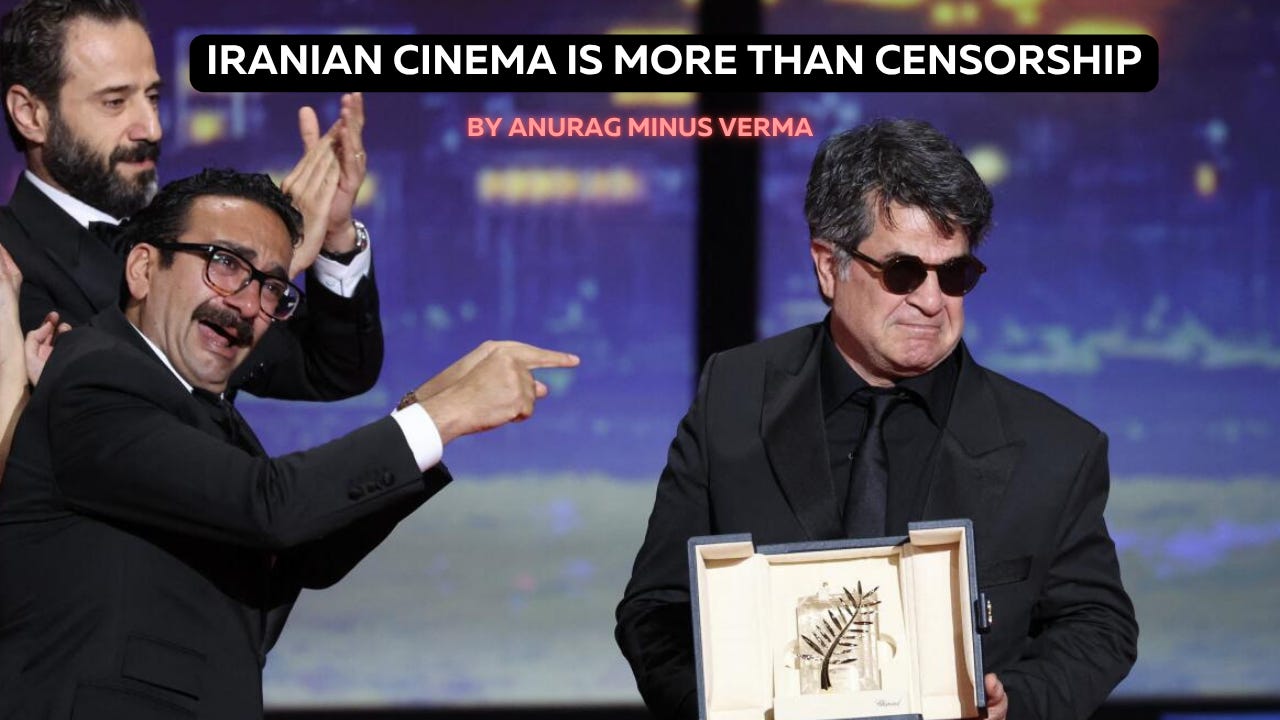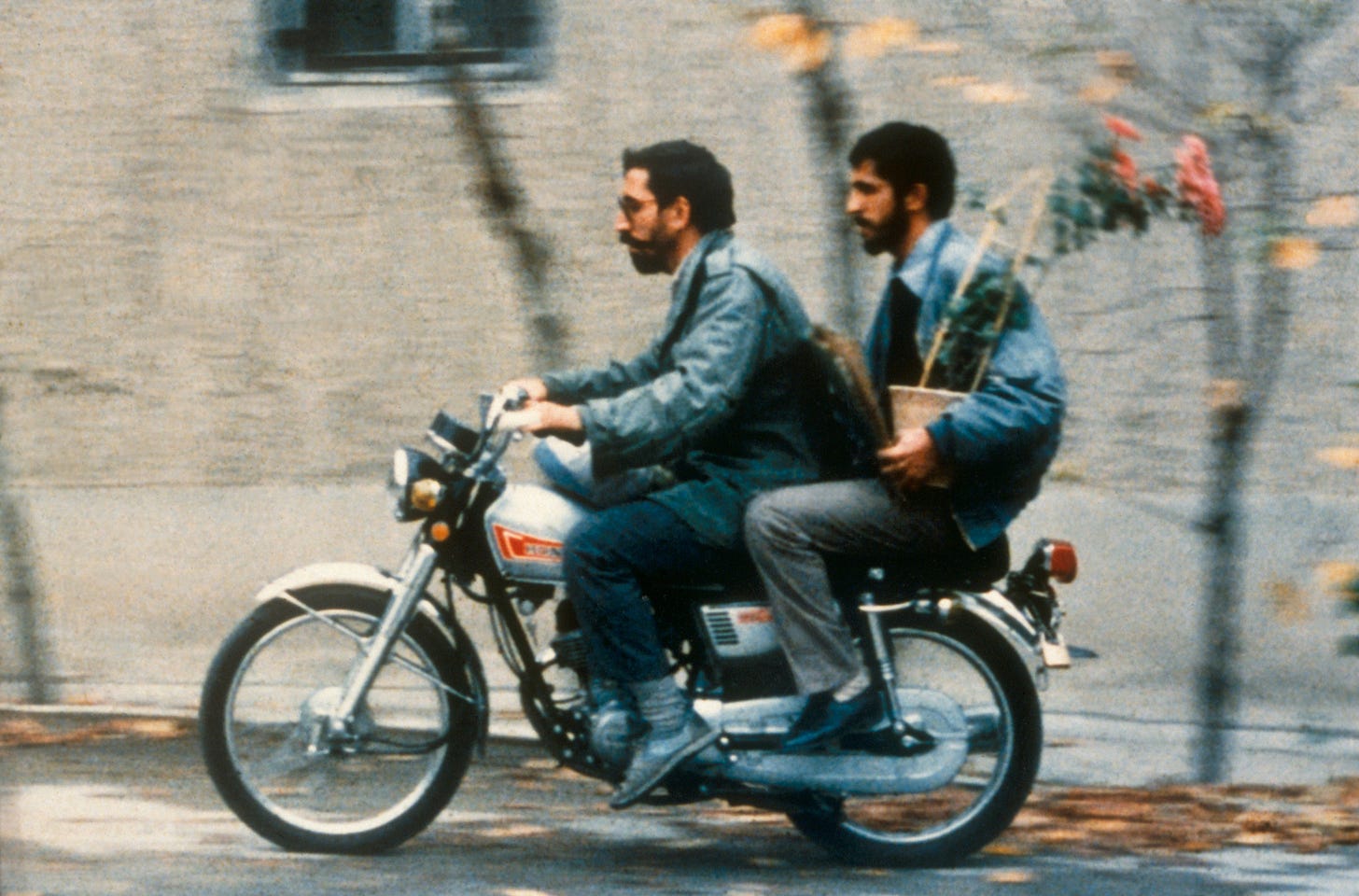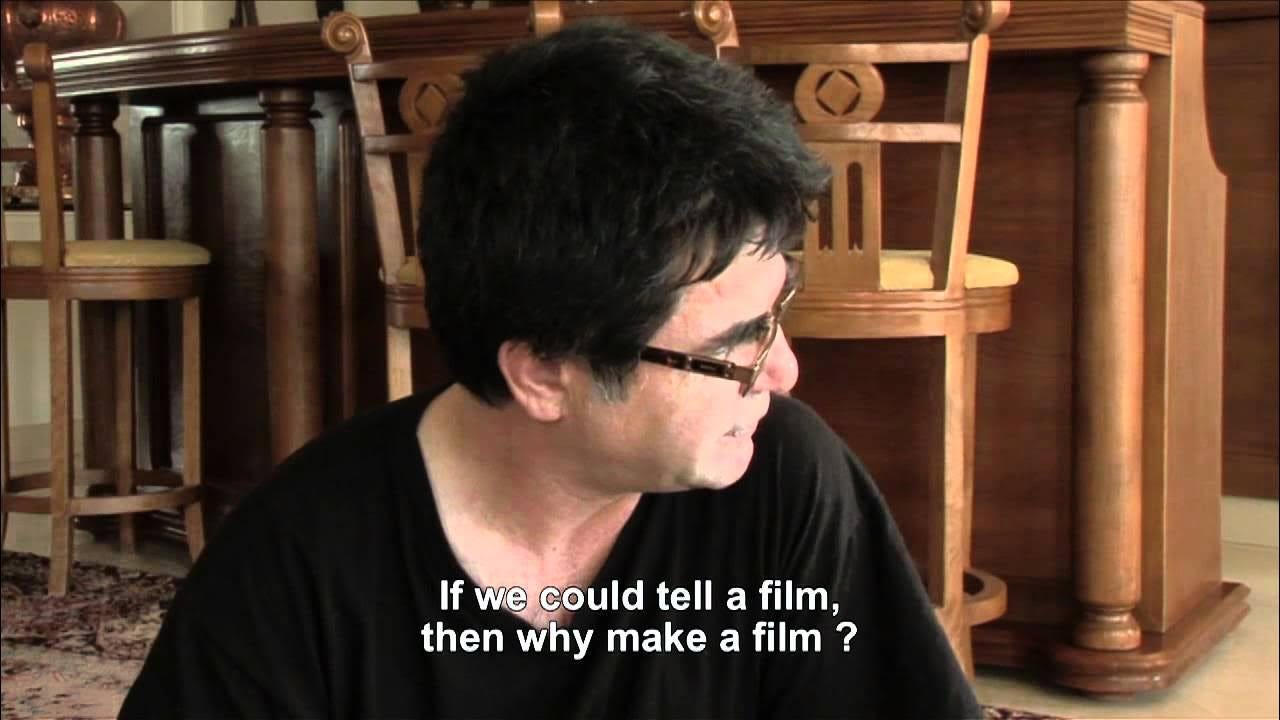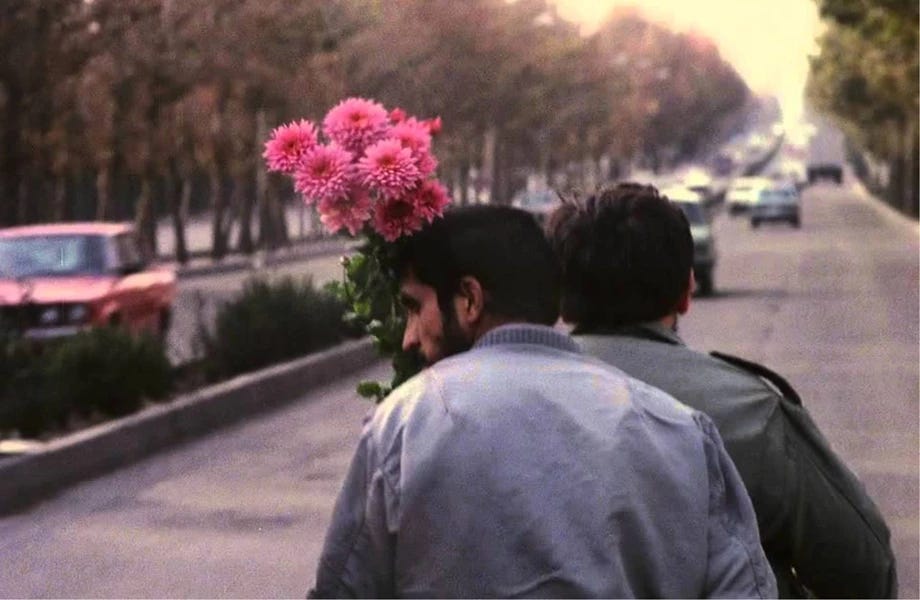Is Iranian Cinema Great Because of Censorship?
Or is India waiting for more censorship to finally make better films?
A few months back, there was a small panel discussion on the question of profanity in cinema and the idea of cinema itself. On the panel were a few filmmakers who call themselves indie but carry the ambition of becoming commercial directors in Bollywood. Even before the event began, I joked to a friend that one of them would almost certainly open with the usual sermon: that censorship produces great cinema, and that we should learn from the Iranians, who apparently make masterpieces every time the state blocks a kiss.
It exactly happened this way. This isn’t even a gotcha moment because this is an argument which these filmmakers repeat so often whenever they are given a comforting chair on panel discussion. It is also a theory, popular also among many people who are call themselves cinephile and and also among some critics who once in their life had made a zero budget short film that Iranian cinema is so profound because of censorship. That if a state clips enough scenes and bans enough words, the artist, like a disciplined monk, will discover the poetry of silence. In this version of events, the Islamic Republic is the unsung co-director of every Iranian masterpiece.
This, of course, is a flat reading, if not outright untrue. It is a kind of Orientalism disguised as praise: the belief that an Iranian filmmaker must be oppressed to be authentic. It is also the Gurudutt-esque fantasy that suffering, by default, makes someone an artist.
It is true that Iranian censorship is bizarre. It functions through a fog of written laws, unwritten customs, and unpredictable mood swings of the authorities. Women must wear the hijab on screen, even when alone in their own homes. Men and women cannot touch, even if they are married in the script and in real life. Romantic affection must be implied, preferably with the emotional intensity of two people waiting for a bus. Singing and dancing are frowned upon. Scripts require approval before shooting, and the final cut can still be blocked after months of production. A film might be cleared and released, only to be quietly yanked from cinemas without explanation.
And yet, in this landscape of bans and bureaucrats, Jafar Panahi managed to make This Is Not a Film while officially banned from filmmaking. He smuggled it out on a USB drive hidden inside a cake. In most countries, cinema is served with popcorn. In Iran, it escapes inside dessert.
But even in the absence of censorship, many artists voluntarily impose limits on themselves-a kind of cinematic brahmacharya. The idea is simple: restrict your tools to avoid the trap of indulgence. This is how filmmakers often force themselves to be more inventive. A well-known example is the Dogme 95 movement, where Danish directors Lars von Trier and Thomas Vinterberg issued a “Vow of Chastity” that banned artificial lighting, non-diegetic music, sets, props, and even director credits. The camera had to be handheld, scenes had to be shot on location, and no sound could be added in post. It was a rebellion not against censorship, but against the comfort of excess.
The idea isn’t unique to cinema. In literature, the French Oulipo movement used constraints to unlock creativity like Georges Perec’s novel La Disparition, written entirely without the letter “e.” In poetry, the haiku restricts itself to 17 syllables and still manages emotional precision. And in Japan, Yasujiro Ozu shot every film with a fixed 50mm lens, kept the camera low to the ground, and rarely changed angles, yet created a body of work of startling emotional clarity. Restraint, in this context, is not punishment. It’s practice.
But to understand Iranian cinema only through the idea of restraint and censorship is to miss the society that shapes it. This is also why many Bollywood indie directors believe that if they make a film slow, remove the music, and include a child walking across a field, the film will somehow feel Iranian. .
What gets missed is that cinema is not just technique, it is a combination of several art forms: painting, poetry, music, theatre. It is also shaped by the culture that produces it. A country’s cinema carries the weight of its civilisation, its memory of beauty, its ways of seeing.
Iran is not simply a country with restrictions; it is also a civilisation with aesthetic memory. Long before filmmakers had to outwit censors, Persian poets had already mastered the art of saying everything without saying it. Hafez, Rumi, and Saadi are part of a philosophical tradition. Iranian cinema inherited this way of seeing. Kiarostami translated this whole idea of minimalism of Iranian art in his films. His long, silent takes and static frames echo Persian miniature paintings, where nothing moves, yet everything speaks with utmost grace.
Majid Majidi makes the kind of films that seem deceptively simple. In Children of Heaven or The Color of Paradise, the protagonists are children, not only because they are cute but because they are structurally necessary. In Iran, where cinema is a constant negotiation with the law, children are among the few characters who can move freely across homes, across genders, and through public and private spaces without violating any codes.
This is not minimalism by choice. It is a cinematic language shaped by what cannot be shown. A lost pair of shoes becomes the centre of Children of Heaven, a plot so modest it slips past the censors while quietly revealing the architecture of class, love, and disappointment.
Iranian filmmakers did not become subtle because they were afraid. They were never trained to scream. For generations, they inherited a culture steeped in poetry, mysticism, and visual restraint. Even before the state stepped in with its red lines, artists were already choosing suggestion over declaration, and silence over spectacle. Beauty in Iranian cinema was never the opposite of sorrow but it was carved out of it.
And hence censorship did not break that tradition. It sharpened it. The constraints forced filmmakers to refine what they were already good at: noticing the small, the quiet, the nearly invisible.
Now compare this with India.
Indian subcontinent, too, comes from a civilisation of staggering artistic fragments. This is the land that produced Kabir, Ravidas, Khusrau, Ghalib, and countless others. Musical traditions both classical and folk stretch across regions and centuries. In visual art, every region has its own grammar: the minimalism of Pahari painting contrasts sharply with the dense narrative detail of Madhubani or the opulence of Mughal miniatures. This is also the land that built architectural marvels whose creators were never named. But the caste system ensured that many brilliant folk poets, musicians, and artisans (most of those were from marginalised communities) were erased from history. Their work was neither archived nor canonised. Their art existed, but it didn’t matter.
Folk music and its beauty were often treated as aesthetic fillers in film, something to appropriate, not engage with. Filmmakers rarely attempted to understand its essence, or the subdued sorrow in the voice of the singer. It was background: pleasant, atmospheric, and disconnected. Or in most cases an exotic item from faraway land. That’s why, when the same music was offered in its purest form on Coke Studio, audience found themselves overwhelmed, sometimes in tears. Not because it was new, but because it was finally presented with respect and grace, not reduction.
There are so many art forms and artistic tradition in the country but what we are left with is an undocumented, scattered picture of our own artistic legacy. Much of it was lost, fragmented, or dismissed as impure. We are a people with a rich cultural past, but without a collective memory of it. Erasure of these memories in many cases are deliberate. That’s why when some privileged-caste filmmakers confidently claim that Iranian cinema is great because of censorship, they rarely pause to ask what art has survived in India and more importantly, whose art was even allowed to be remembered.
So when you suggest that more censorship can result into better art then this argument can’t be more wrong. It won’t provoke artistic ingenuity, it simply replaces silence with rhetoric. More censorship in India many not give birth to metaphor; it will give birth to louder rhetorical speeches, conveniently framed as rebellion. A character will deliver a monologue, slightly critical, and critics will applaud the "bravery." Many in India believe that Shah Rukh Khan's Jawan is a rebellious, anti-authoritarian film.
Artistic merit is only calculated on the metric of decibel. Even on OTT and at film festivals we are already watching films that speak of ‘issues’ as if you are reading a newspaper, but in terms of form and style they have nothing original or rooted. Because the people who are making films on ‘issues’ are generationally responsible for creating these very ‘issues.’ There is no honest enquiry into the nation, society, or art. Just performance. And more empty performances.
This is why, without honesty, there is no cinema, no poetry, and no art. The best of Iranian cinema is not defined by censorship alone, but by a sense of place. But let me be clear, this isn’t to claim that all Iranian films are brilliant or that Indian cinema is entirely hollow. Iran produces its share of mediocrity. It is not an artistic utopia where everyone wakes up quoting poets before breakfast. In fact, I recently met a filmmaker from Iran, and after an hour of conversation, I was comforted by a simple truth: mediocrity is the one thing that truly unites humanity.
So the point is not to romanticise any country’s output, but to recognise that the best Iranian filmmakers respond to censorship with a cultural depth that comes from the artistic atmosphere of their own civilisation. Iranian cinema gives the illusion that censorship breeds poetry. But it only works there because the civilisation had a poetic temperament long before the state began cutting scenes.
Censorship can silence a film. But the real tragedy is when the filmmaker has nothing to say even with the mic on and set to 10 db volume.
The absence of freedom is unfortunate. The absence of thought is fatal.
I keep my writing free on Substack, but writing and creating comes with its own labour. If you appreciate the work, consider supporting. It helps me pay the bills. You can directly contribute here: Minusverma@upi . Here is Razorpay that has options for UPI & PayPal and here’s BuyMeACoffee.







This article comes at an interesting time. Few days back I was thinking about exploring Iranian cinema, I watched Panah Panahi’s ‘Hit the road’, then found out that he is son of a renowned filmmaker Jafar Panahi, I then watched ‘Taxi’. I was in the middle of ‘No Bears’ when the news broke that he got Palm d’Or for his latest film. Then AMV shared a meme about an Indian actress receiving a splendid welcome back from Cannes, AMV said “Jafar Panahi can only dream of this”. I was glad I got the reference! And btw I thought this comment would be much more interesting when I started writing it 🙏🏼
What a beautiful piece of writing Anurag! The way you have structured the sentences feels so conversational, easy to understand, and yet have a thoughtful reflection on the same.